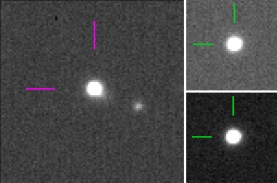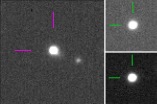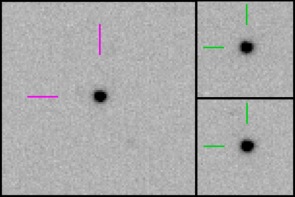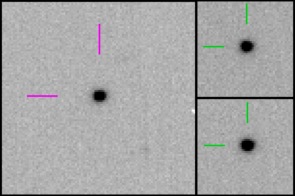Advanced comet hunting (Part 1)
So, for those of you who have been itching to do deeper analysis of Comet Hunters images, this blog post is for you! With the information provided here, you will be able to do many additional types of analyses if you are so inclined, but the two tasks we will focus on here are (1) checking for cases of overlapping objects, and (2) checking for consistency in an object’s appearance.
Subject information: The key to being able to perform follow-up analyses of Comet Hunters images is this table (*UPDATE* see link to updated table below) that lists the corresponding meta data for all asteroid subjects currently being shown on Comet Hunters (excluding images of known comets). The format of the file looks something like this:
SubjID ObjNum ObjName Date Time ExpT ObjRA ObjDec Filename ObsTarget 1288778 172 Baucis 2007-06-15 12:53:37 60.0 0.35268 0.08548 SUPA00547638.fits F04 1288832 172 Baucis 2007-06-15 13:01:48 60.0 0.35446 0.08665 SUPA00547678.fits F04 1288891 172 Baucis 2007-06-15 13:09:56 60.0 0.35623 0.08782 SUPA00547718.fits F04
The listed columns are subject ID (SubjID), asteroid number (ObjNum), asteroid name (ObjName), date of the original observation (Date), time of the original observation (Time), exposure time (ExpT; in seconds), Right Ascension (ObjRA; in decimal degree format), Declination (ObjDec; in decimal degree format), name of the original data file (Filename), and the original observation target (ObsTarget).
We should note that there are some duplicate images in this list where the same asteroid appears as two different subjects, one generated for the beta test (which used red crosshairs for the asteroid) and another for the official launch of the project (which uses purple crosshairs), so just be aware of this.
Overlapping objects: So, as explained in this previous blog post, determining whether something that looks like a comet tail is actually just a background star or galaxy behind our target asteroid involves looking for images of the same part of the sky, and even taken on the same night if possible, and checking to see if the activity “moves” along with the asteroid (in which case, it may be a real tail), or if it instead appears to remain stationary in the sky (in which case, it is a background object). The science team refers back to the original data files corresponding to each subject to make this determination, but it’s actually possible to do the same type of check simply using the Comet Hunters website.
This technique was actually demonstrated in our previous blog post about detecting overlaps, except that now with the individual subject data we provide you, you can search for other images of an asteroid of interest on your own. So to follow the previous example, if you found that Subject 1295819 looked like a possible comet:

You could then refer to the data table to search for the subject number “1295819” and find out that it refers to an image taken of asteroid (27473) 2000 GV78 on 2008-11-29 at 5:45:06.727 (Universal Time). The file is currently sorted by asteroid number, so you will then note that there are several other images of asteroid (27473) also taken on 2008-11-29 that have been turned into Comet Hunters subjects, namely Subjects 1295829, 1295842, 1295854, 1295866, and 1295876. To retrieve these images, simply replace the subject number at the end of the following URL:
https://www.zooniverse.org/projects/mschwamb/comet-hunters/talk/subjects/1295819
and then by looking at the images side by side, you may be able to see the asteroid moving across the background object, revealing that the original suspected cometary activity was a case of the asteroid overlapping a background star or galaxy.




Checking for overlaps will not always be easy though. Consecutive images of other asteroids may not have been obtained close in time, so background stars may change significantly from image to image. We use software to automatically set the contrast levels of the images we display and so images of the same asteroid may sometimes be set to different levels, making the brightness of both the asteroid and background stars/galaxies appear different in different images. Image quality may also change from one image to the next, or some images may have tracking problems but not others. We are also still fixing the problem that we’ve found where objects were improperly centered by our software, so asteroids may be centered in some images but not others. In many cases though, this simple analysis should allow you to identify subjects that are clear overlap cases, which will help the science team as we work to weed those out in order to get to genuine comet candidates.
Checking for consistent appearances: Besides checking for overlaps, looking at other images of the same asteroid taken on the same night allows us to check to see if suspected cometary activity, especially faint activity, remains consistent from one image to the next. If an object shows activity in one image but not others, it is probably just caused by noise and is not what we would consider a good candidate for further follow-up.
For example, Subject 1295853 looks like it may have a faint tail at the 11 o’clock position:

However, looking at Subjects 1295818, 1295839, and 1295865, which are also images of asteroid (336184) 2008 RN107 from 2008-11-29, the same feature does not appear in any of the other images.




In this case, we would then conclude that the original suspected cometary feature is not real.
Other Analyses: In (a) future blog post(s), we will describe other types of analyses you can do with the data table we now provide, including using the raw FITS files, searching for other instances of observations of an asteroid of interest from different telescopes, retrieving and interpreting information about the orbit and viewing geometry of an asteroid of interest at the time of observations, and more.
*Update (2016-06-02): Here is the updated data table that includes new data uploaded to the Comet Hunters project since this blog post was first posted. Happy hunting!
*Update (2017-05-16): Due to a change in Dropbox’s file settings, the previously posted link to the data table no longer works. Go here instead for the updated data table posted on 2016-06-02.

Nice article.
Have you ever consider adding this functionality directly to the classification page, such as by adding a button to allow the user to cycling through the various images of the asteroid at different points in time to help determine if it’s an overlap? Since each asteroid has a unique ID, it doesn’t sound too difficult from the database perspective at least.
LikeLike
Hi Alexander,
Thanks, glad to hear you found the article informative. You’re absolutely right that being able to automatically access other images of an asteroid would streamline the overlap checking process. Unfortunately, the current platform on which the CometHunters website is based (see https://blog.zooniverse.org/2015/06/29/a-whole-new-zooniverse/) doesn’t really allow that level of customization at this time. It’s not a bad thing though…this new platform just means that the Zooniverse can support more projects than they would be able to otherwise, and also get those projects out to the public more quickly. So, there’s loss in some customizability in exchange for many more projects (including ours) … I guess we could consider that a fair trade. 🙂 In any case, if you (or anyone else reading this) have any further questions or ideas for how we can make this project better/easier to use, please let us know. No guarantees we will be able to do exactly what you suggest, but if there’s any way that we can do something similar, we can certainly try!
Cheers,
Henry
LikeLike